The Social Production of Industrial Heritage Spaces in the Background of Cultural Governance: A Comparative Study Based on Cases from Taipei and Hong Kong
Abstract
1. Introduction
2. Methodology
2.1. Research Methods
2.2. Research Framework
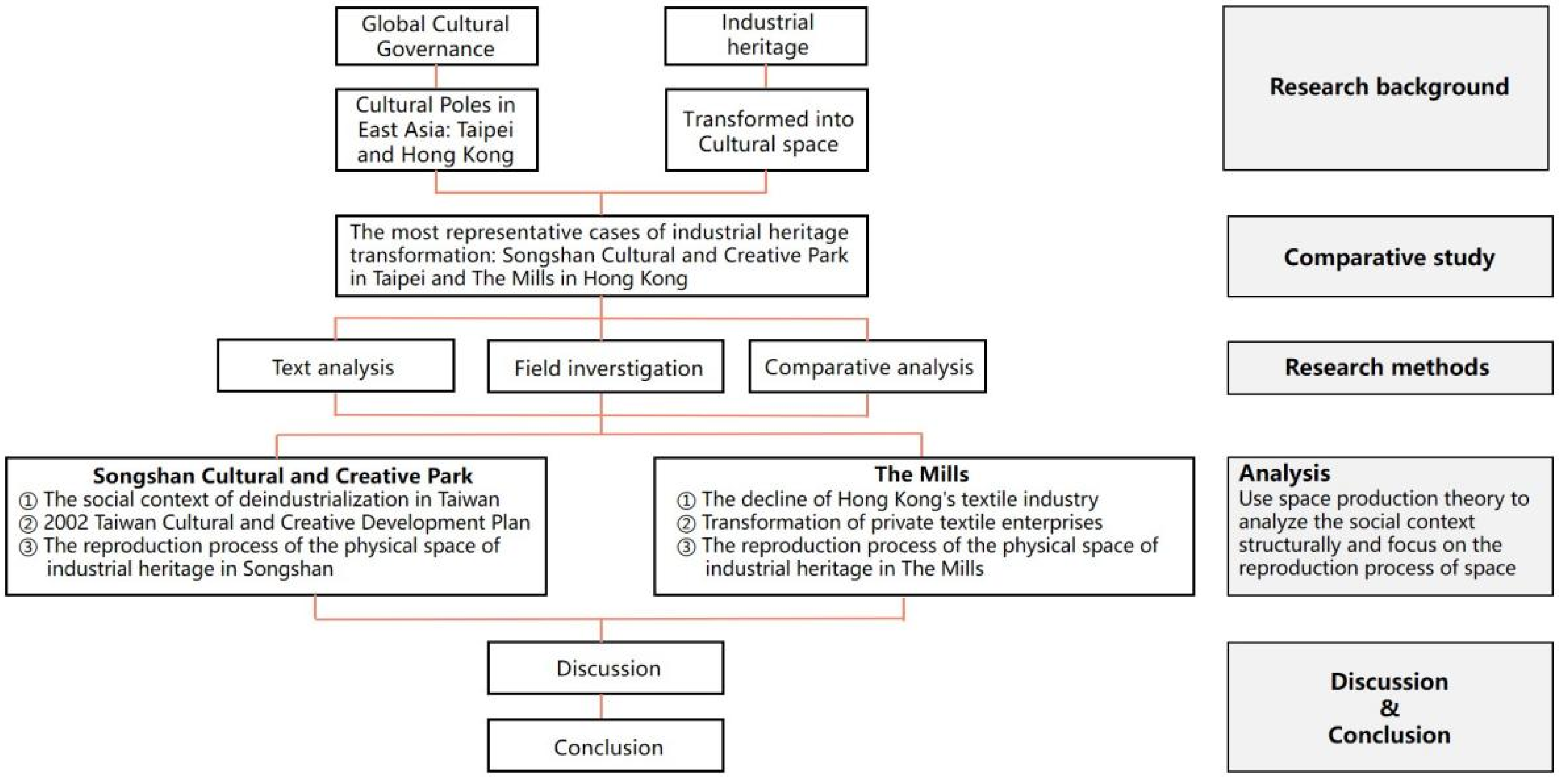
3. Literature Review: Transition from Industrial City to Cultural City
3.1. Cultural Governance and Global City Competition
3.2. Cultural-Led Production of Urban Space
3.3. Transfer of Development Rights and the Protection of Cultural Heritage
3.4. Protection and Activation of Industrial Buildings
4. The Social Production of East Asia’s Industrial Heritages: Case Studies
4.1. Songshan Cultural and Creative Park in Taipei: Cultural Policy Reshaping Industrial Space under the Banner of “Creative Taiwan”
4.1.1. The Historical Background of Songshan Cultural and Creative Park
4.1.2. The Social Production of Songshan Cultural and Creative Park
4.2. The Mills in Hong Kong: The Decline of the Textile Industry and the Transformation of the Enterprise
4.2.1. The Epitome of Hong Kong’s Textile Industry: The Prosperity and Decline of Nan Fung Yarn Mill
4.2.2. The Space Production of the Mills: Commercial Modernization of Factory Space
5. Discussion
5.1. Cultural Heritage Conservation Policies in Taipei and Hong Kong
5.2. The Social Production of Songshan Cultural and Creative Park: Community Participation and Industrial Development
5.3. Revitalization of the Mills: Social Production from Traditional Spinning Mills to Cultural and Commercial Spaces
6. Conclusions
Funding
Conflicts of Interest
| 1 | Cultural Industrialization: To use creativity, imagination, and technology to package culture, making cultural products and developing cultural industries with both cultural value and economic benefits. http://blog.udn.com/andyfish/26209, accessed on 10 January 2023. |
| 2 | The Cultural and Creative Industries Development Plan defines the elements of Taiwan’s cultural and creative industries, covering multiple categories. https://www.cuhk.edu.hk/ics/21c/media/articles/c133-201209018, accessed on 10 January 2023. |
| 3 | Big Moments from World Design Capital Taipei. https://wdc2016.taipei/, accessed on 20 December 2022. |
| 4 | Taiwan Cultural Assets Preservation Act, https://law.moj.gov.tw/LawClass/LawAll.aspx?PCode=H0170001, accessed on 20 December 2022. |
| 5 | The official website of The Mills, https://www.themills.com.hk/en/about-the-mills/history-heritage, accessed on 24 February 2023. |
| 6 | Reform and opening-up policy: Guided by Deng Xiaoping, the reforms were launched by reformists within the Chinese Communist Party in 1978, the reforms led to significant economic growth for China within the successive decades. |
| 7 | Arup Group Limited is a British multinational professional services firm headquartered in London that provides design, engineering, architecture, planning, and advisory services across every aspect of the built environment. |
| 8 | Introduction to the development concept of Songshan Cultural and Creative Park. For more details, refer to https://www.songshanculturalpark.org/about, accessed on 10 January 2023. |
| 9 | Complete Guide to Songshan Cultural and Creative Park. For more details, refer to https://www.songshanculturalpark.org/exhibition/activity/757e4366-eb9c-4bf5-b199-c41487afb885, accessed on 10 January 2023. |
References
- Amin, A. Collective Culture and Urban Public Space. City 2008, 12, 5–24. [Google Scholar] [CrossRef]
- Rotenberg, R.L.; McDonogh, G.W. The Cultural Meaning of Urban Space; Greenwood: London, UK, 1993. [Google Scholar]
- Stevenson, D. Cities and Urban Cultures; McGraw-Hill Education: London, UK, 2003. [Google Scholar]
- Zukin, S.; Kasinitz, P.; Chen, X. Global Cities, Local Streets: Everyday Diversity from New York to Shanghai; Routledge: London, UK, 2015. [Google Scholar]
- Lemke, T. Foucault, Governmentality, and Critique. Rethink. Marx. 2002, 14, 49–64. [Google Scholar] [CrossRef]
- Lemke, T. Foucault’s Analysis of Modern Governmentality: A Critique of Political Reason. Verso Books. 2019. Available online: https://books.google.com.hk/books?hl=en&lr=&id=TYyFDwAAQBAJ&oi=fnd&pg=PR10&dq=Foucault%E2%80%99s+Analysis+of+Modern+Governmentality:+A+Critique+of+Political+Reason&ots=CT9q4MnAxP&sig=oEf3yVzPr9zCtnXFMJRxL2o_Kro&redir_esc=y#v=onepage&q=Foucault%E2%80%99s%20Analysis%20of%20Modern%20Governmentality%3A%20A%20Critique%20of%20Political%20Reason&f=false (accessed on 21 January 2023).
- Aina, Y.A.; Wafer, A.; Ahmed, F.; Alshuwaikhat, H.M. Top-down Sustainable Urban Development? Urban Governance Transformation in Saudi Arabia. Cities 2019, 90, 272–281. [Google Scholar] [CrossRef]
- Wang, C.-H. The Cultural Governance of Taipei City, 1967-2002. Taiwan Soc. Res. Q. 2003, 52, 121–186. [Google Scholar]
- Gerometta, J.; Haussermann, H.; Longo, G. Social Innovation and Civil Society in Urban Governance: Strategies for an Inclusive City. Urban Stud. 2005, 42, 2007–2021. [Google Scholar] [CrossRef]
- Xia, S.; Liu, B.; Wang, H. Construction of a Sustainability-Based Building Attribute Conservation Assessment Model in Historic Areas. Buildings 2022, 12, 1346. [Google Scholar] [CrossRef]
- Paddison, R.; Miles, R.S. Culture-Led Urban Regeneration; Routledge: London, UK, 2020. [Google Scholar]
- Elshater, A.; Abusaada, H. Developing Process for Selecting Research Techniques in Urban Planning and Urban Design with a PRISMA-Compliant Review. Soc. Sci. 2022, 11, 471. [Google Scholar] [CrossRef]
- McDonald, J.F. Chicago’s Industrial Decline: The Failure of Redevelopment, 1920–1975. By Robert Lewis. Ithaca: Cornell University Press, 2020. Xi+ 256 Pp. Figures, Tables, Bibliography, Index. ISBN: 978-1-5017-5262-9. Bus. Hist. Rev. 2021, 95, 580–582. [Google Scholar] [CrossRef]
- Shetty, S.; Reid, N. Dealing with Decline in Old Industrial Cities in Europe and the United States: Problems and Policies. Built Environ. 2014, 40, 458–474. [Google Scholar] [CrossRef]
- Haase, A.; Bontje, M.; Couch, C.; Marcinczak, S.; Rink, D.; Rumpel, P.; Wolff, M. Factors Driving the Regrowth of European Cities and the Role of Local and Contextual Impacts: A Contrasting Analysis of Regrowing and Shrinking Cities. Cities 2021, 108, 102942. [Google Scholar] [CrossRef]
- Döringer, S.; Uchiyama, Y.; Penker, M.; Kohsaka, R. A Meta-Analysis of Shrinking Cities in Europe and Japan. Towards an Integrative Research Agenda. Eur. Plan. Stud. 2020, 28, 1693–1712. [Google Scholar] [CrossRef]
- Hoffmann, B. Air Pollution in Cities: Urban and Transport Planning Determinants and Health in Cities. In Integrating Human Health into Urban and Transport Planning; Springer: Cham, Switzerland, 2019; pp. 425–441. [Google Scholar] [CrossRef]
- Nijkamp, P.; Perrels, A. Sustainable Cities in Europe; Routledge: London, UK, 2014. [Google Scholar]
- Haase, D. Urban Ecology of Shrinking Cities: An Unrecognized Opportunity? Nat. Cult. 2008, 3, 1–8. [Google Scholar] [CrossRef]
- Heynen, N. Green Urban Political Ecologies: Toward a Better Understanding of Inner-City Environmental Change. Environ. Plan. A 2006, 38, 499–516. [Google Scholar] [CrossRef]
- Sacco, P.L.; Ghirardi, S.; Tartari, M.; Trimarchi, M. Two Versions of Heterotopia: The Role of Art Practices in Participative Urban Renewal Processes. Cities 2019, 89, 199–208. [Google Scholar] [CrossRef]
- Wallace, R.; Wallace, D.; Ullmann, E., John; Andrews, H. Deindustrialization, Inner-City Decay, and the Hierarchical Diffusion of AIDS in the USA: How Neoliberal and Cold War Policies Magnified the Ecological Niche for Emerging Infections and Created a National Security Crisis. Environ. Plan. A 1999, 31, 113–139. [Google Scholar] [CrossRef]
- Paskannaya, T.; Shaban, G. Innovations in Green Logistics in Smart Cities: USA and EU Experience. 2019. Available online: https://scholar.archive.org/work/63ndpisrufh3pb7qboknxl5cle (accessed on 21 January 2023).
- Zhong, S. Artists and Shanghai’s Culture-Led Urban Regeneration. Cities 2016, 56, 165–171. [Google Scholar] [CrossRef]
- Fleischmann, K.; Welters, R.; Daniel, R. Creative Industries and Regional Economic Development: Can a Creative Industries Hub Spark New Ways to Grow a Regional Economy? Australas. J. Reg. Stud. 2017, 23, 217–242. [Google Scholar]
- Perry, E.J. Cultural Governance in Contemporary China: “Re-Orienting” Party Propaganda. In o Govern China: Evolving Practices of Power; Cambridge University Press: Cambridge, UK, 2017; pp. 29–55. [Google Scholar] [CrossRef]
- Ng, M.-K. Intellectuals and the Production of Space in the Urban Renewal Process in Hong Kong and Taipei. Plan. Theory Pract. 2014, 15, 77–92. [Google Scholar] [CrossRef]
- Karvelyte, K. Shifting Meanings in Changing Contexts: The Role of the Creative City in Shanghai, Hong Kong and Taipei. Int. J. Cult. Policy 2020, 26, 166–183. [Google Scholar] [CrossRef]
- Tang, S.F. Making Artist Neighbourhoods: Production of Urban Space and Culture in Hong Kong and Taipei. 2012. Available online: https://hub.hku.hk/handle/10722/184260 (accessed on 11 January 2023).
- Hsin-Huang, M.H.; Po-san, W. Lifestyle and Class: The Experiences of Cultural Globalization in Taipei and Hong Kong. Korea Obs. 2006, 37, 181. [Google Scholar]
- Lefebvre, H. From the Production of Space. In Theatre and Performance Design; Routledge: London, UK, 2012; pp. 81–84. [Google Scholar]
- King, I.W.; Schramme, A. Cultural Governance in a Global Context: An International Perspective on Art Organizations; Springer: Cham, Switzerland, 2019. [Google Scholar]
- Bain, A.L.; Landau, F. Artists, Temporality, and the Governance of Collaborative Place-Making. Urban Aff. Rev. 2019, 55, 405–427. [Google Scholar] [CrossRef]
- Wang, C.-H.; Kao, Y.-T. Spatial Politics in the Transformation of Art and Culture Venues in the Taipei City: An Infrastructurization Perspective. J. Geogr. Res. 2019, 70, 1–31. [Google Scholar]
- Cleaver, F.; Whaley, L. Understanding Process, Power, and Meaning in Adaptive Governance. Ecol. Soc. 2018, 23, 2. [Google Scholar] [CrossRef]
- De Dios, A.; Kong, L. Handbook on the Geographies of Creativity; Edward Elgar Publishing: Cheltenham, UK, 2020. [Google Scholar]
- Buck, N.; Gordon, I.R.; Harding, A. Changing Cities: Rethinking Urban Competitiveness, Cohesion and Governance; Bloomsbury Publishing: London, UK, 2017. [Google Scholar]
- Kong, L.; Chia-Ho, C.; Tsu-Lung, C. Arts, Culture and the Making of Global Cities: Creating New Urban Landscapes in Asia; Edward Elgar Publishing: Cheltenham, UK, 2015. [Google Scholar]
- Lei, H.; Zhou, Y. Conducting Heritage Tourism-Led Urban Renewal in Chinese Historical and Cultural Urban Spaces: A Case Study of Datong. Land 2022, 11, 2122. [Google Scholar] [CrossRef]
- Sepe, M. Urban Transformation, Socio-Economic Regeneration and Participation: Two Cases of Creative Urban Regeneration. Int. J. Urban Sustain. Dev. 2014, 6, 20–41. [Google Scholar] [CrossRef]
- Liu, G.; others. Reasons for Decline and Strategies for Re-Emerge of American Manufacturing Industries: The Case of Motor City Detroit. Int. J. New Dev. Eng. Soc. 2020, 4, 1–17. [Google Scholar]
- Herrmann, C.; Juraschek, M.; Burggräf, P.; Kara, S. Urban Production: State of the Art and Future Trends for Urban Factories. CIRP Ann. 2020, 69, 764–787. [Google Scholar] [CrossRef]
- Dinardi, C. Grassroots Creative Hubs: Urban Regeneration, Recovered Industrial Factories and Cultural Production in Buenos Aires and Rio de Janeiro. In Creative Hubs in Question. Dynamics of Virtual Work; Palgrave Macmillan: Cham, Switzerland, 2019; pp. 299–317. [Google Scholar] [CrossRef]
- Li, J. Culture and Tourism-Led Peri-Urban Transformation in China–The Case of Shanghai. Cities 2020, 99, 102628. [Google Scholar] [CrossRef]
- Richards, G. Designing Creative Places: The Role of Creative Tourism. Ann. Tour. Res. 2020, 85, 102922. [Google Scholar] [CrossRef]
- Gutierrez-Posada, D.; Kitsos, T.; Nathan, M.; Nuccio, M. Creative Clusters and Creative Multipliers: Evidence from UK Cities. Econ. Geogr. 2023, 99, 1–24. [Google Scholar] [CrossRef]
- Johnston, R.A.; Madison, M.E. From Land Marks to Landscapes: A Review of Current Practices in the Transfer of Development Rights. J. Am. Plann. Assoc. 1997, 63, 365–378. [Google Scholar] [CrossRef]
- Hills Jr, R.M.; Schleicher, D. Building Coalitions Out of Thin Air: Transferable Development Rights and “Constituency Effects” in Land Use Law. J. Leg. Anal. 2020, 12, 79–135. [Google Scholar] [CrossRef]
- Shao, Z.; Xu, J.; Chung, C.K.L.; Spit, T.; Wu, Q. The State as Both Regulator and Player: The Politics of Transfer of Development Rights in China. Int. J. Urban Reg. Res. 2020, 44, 38–54. [Google Scholar] [CrossRef]
- Li, P. Transfer of Development Rights Approach: Striking the Balance between Economic Development and Historic Preservation in Hong Kong. Surv. Built Environ. 2008, 19, 38–53. [Google Scholar]
- Pizor, P.J. Making TDR Work: A Study of Program Implementation. J. Am. Plann. Assoc. 1986, 52, 203–211. [Google Scholar] [CrossRef]
- Guzle, G.; Akpınar, F.; Duvarcı, Y. Transfer of Development Rights for the Effectiveness of the Conservation Plans: A Case from Historic Kemeraltı, Izmir. Habitat Int. 2020, 103, 102207. [Google Scholar] [CrossRef]
- Machemer, P.L.; Kaplowitz, M.D. A Framework for Evaluating Transferable Development Rights Programmes. J. Environ. Plan. Manag. 2002, 45, 773–795. [Google Scholar] [CrossRef]
- Wang, H.; He, C.; Li, W.; Nie, X.; Zhong, H.; Wen, L. Will Transferable Development Rights (TDR) Increase Regional Economic Imbalance?—A Quota Transaction Case of Cultivated Land Conversion and Reclamation in Guangxi, China. Habitat Int. 2020, 104, 102254. [Google Scholar] [CrossRef]
- Shih, M.; Chiang, Y.-H.; Chang, H.B. Where Does Floating TDR Land? An Analysis of Location Attributes in Real Estate Development in Taiwan. Land Use Policy 2019, 82, 832–840. [Google Scholar] [CrossRef]
- Nallathiga, R. Land-Based Instruments for Urban Infrastructure Development: The Experience of TDR in Mumbai. NICMAR J. Constr. Manag. Res. 2014, 29, 51–65. [Google Scholar] [CrossRef]
- Bruno, E.; Falco, E.; Shahab, S.; Geneletti, D. Integrating Ecosystem Services in Transfer of Development Rights: A Literature Review. Land Use Policy 2023, 131, 106694. [Google Scholar] [CrossRef]
- Cudny, W. The Ironbridge Gorge Heritage Site and Its Local and Regional Functions. Bull. Geogr. Socio-Econ. Ser. 2017, 36, 61–75. [Google Scholar] [CrossRef]
- Douet, J. Industrial Heritage Re-Tooled: The TICCIH Guide to Industrial Heritage Conservation; Routledge: New York, NY, USA, 2016. [Google Scholar]
- Gottdiener, M.; Hohle, R.; King, C. The New Urban Sociology; Routledge: New York, NY, USA, 2019. [Google Scholar]
- Zhang, W.; Zhang, X.; Wu, G. The Network Governance of Urban Renewal: A Comparative Analysis of Two Cities in China. Land Use Policy 2021, 106, 105448. [Google Scholar] [CrossRef]
- Nocca, F. The Role of Cultural Heritage in Sustainable Development: Multidimensional Indicators as Decision-Making Tool. Sustainability 2017, 9, 1882. [Google Scholar] [CrossRef]
- Yeung, H.W. Strategic Coupling: East Asian Industrial Transformation in the New Global Economy; Cornell University Press: Ithaca, NY, USA, 2016. [Google Scholar]
- Inglehart, R. Culture Shift in Advanced Industrial Society; Princeton University Press: Princeton, NJ, USA, 2018. [Google Scholar]
- Labadi, S.; Giliberto, F.; Rosetti, I.; Shetabi, L.; Yildirim, E. Heritage and the Sustainable Development Goals: Policy Guidance for Heritage and Development Actors. Int. J. Herit. Stud. 2021, 1–70. [Google Scholar]
- Wong, W.S. Design History and Study in East Asia: Part 2 Greater China: People’s Republic of China/Hong Kong/Taiwan. J. Des. Hist. 2011, 24, 375–395. [Google Scholar] [CrossRef]
- Sun, M.; Chen, C. Renovation of Industrial Heritage Sites and Sustainable Urban Regeneration in Post-Industrial Shanghai. J. Urban Aff. 2023, 45, 729–752. [Google Scholar] [CrossRef]
- Chow, P.C. The Path of Taiwans Industrial Development: From Follower to Innovator. In A Century of Development in Taiwan; Edward Elgar Publishing: Cheltenham, UK, 2022; pp. 149–178. [Google Scholar]
- Rigger, S. The Tiger Leading the Dragon: How Taiwan Propelled China’s Economic Rise; Rowman & Littlefield: Lanham, ML, USA, 2021. [Google Scholar]
- Qiang, X. Selective Engagement: Mainland China’s Dual-Track Taiwan Policy. J. Contemp. China 2020, 29, 535–552. [Google Scholar] [CrossRef]
- Chen, S.-C.; Lee, D.-S.; Huang, C.-Y. Evaluating the Sustainable Operating Performance of Electronics Industry Groups: Taiwanese Firms in Mainland China. Sustainability 2021, 13, 12030. [Google Scholar] [CrossRef]
- Lei, C.F. The Spatial Inclusion and Exclusion of Culture-Led Regeneration in Taipei: A Case Study of Songshan Cultural Creative Park. 2015. Available online: https://www.airitilibrary.com/Publication/alDetailedMesh1?DocID=U0023-1005201615092448 (accessed on 11 January 2023).
- Lee, C.B. Cultural Policy and Governance: Reviewing Policies Related to Cultural and Creative Industries Implemented by the Central Government of Taiwan between 2002 and 2012. Rev. Policy Res. 2015, 32, 465–484. [Google Scholar] [CrossRef]
- Ding, H.; Hung, K.-P.; Peng, N.; Chen, A. Experiential Value of Exhibition in the Cultural and Creative Park: Antecedents and Effects on CCP Experiential Value and Behavior Intentions. Sustainability 2021, 13, 7100. [Google Scholar] [CrossRef]
- Chen, A.; Peng, N.; Hung, K. Examining Tourists’ Loyalty toward Cultural Quarters. Ann. Tour. Res. 2015, 51, 59–63. [Google Scholar] [CrossRef]
- Chiu, S.W. City States in the Global Economy: Industrial Restructuring in Hong Kong and Singapore; Routledge: London, UK, 2018. [Google Scholar]
- Cheng, L.K.; Fung, W.K. The Globalization of Trade and Production: A Case Study of Hong Kong’s Textile and Clothing Industries. Glob. Prod. Trade East Asia 2001, 2001, 227–243. [Google Scholar]
- Huang, R.; Yan, P.; Yang, X. Knowledge Map Visualization of Technology Hotspots and Development Trends in China’s Textile Manufacturing Industry. IET Collab. Intell. Manuf. 2021, 3, 243–251. [Google Scholar] [CrossRef]
- Wang, Y.-J.; Wu, C.; Yuan, J. Exploring Visitors’ Experiences and Intention to Revisit a Heritage Destination: The Case for Lukang, Taiwan. J. Qual. Assur. Hosp. Tour. 2010, 11, 162–178. [Google Scholar] [CrossRef]
- Yang, W.-B.; Yen, Y.-N.; Cheng, H.-M. An Integrated Management System for Historical Buildings: The Case Study of Dihua Historical Street Districts in Taiwan. In Proceedings of the Progress in Cultural Heritage Preservation: 4th International Conference, EuroMed 2012, Limassol, Cyprus, 29 October–3 November 2012; Proceedings 4; Springer: Berlin/Heidelberg, Germany, 2012; pp. 594–601. [Google Scholar]
- Chen, C.-C.; Fu, C.-C. Globalization and Localization of Heritage Preservation in Taiwan–an Analysis Perspective under the Cultural Heritage Preservation Act. Int. Arch. Photogramm. Remote Sens. Spat. Inf. Sci. 2015, 40, 65–72. [Google Scholar] [CrossRef]
- Fung, I.W.; Tsang, Y.; Tam, V.W.; Xu, Y.; Mok, E.C. A Review on Historic Building Conservation: A Comparison between Hong Kong and Macau Systems. Renew. Sustain. Energy Rev. 2017, 71, 927–942. [Google Scholar] [CrossRef]
- Yung, E.H.; Langston, C.; Chan, E.H. Adaptive Reuse of Traditional Chinese Shophouses in Government-Led Urban Renewal Projects in Hong Kong. Cities 2014, 39, 87–98. [Google Scholar] [CrossRef]
- Chang, C.; Chai, Y. Experiences and Enlightenments of Industrial Community Reuse in Taiwan: A Case Study of Songshan Cultural and Creative Park. Areal Res. Dev. 2017, 36, 69–74. [Google Scholar]
- Rietdijk, C.E. Consensus Politics in the Urban Political Arena: Implications for Urban Development in the Greater Taipei Metropolitan Region. Geogr. Study 2022, 76, 97–120. [Google Scholar]
- Light, I. Emigrant Entrepreneurs: Shanghai Industrialists in Hong Kong. Am. J. Sociol. 1990, 96, 249–251. [Google Scholar] [CrossRef]
- Siu, K.; Siu, K. Hong Kong Female Garment Workers and China’s Open Door. Chin. Migr. Work. Empl. Domin. Comp. Hong Kong Vietnam 2020, 2020, 23–45. [Google Scholar]
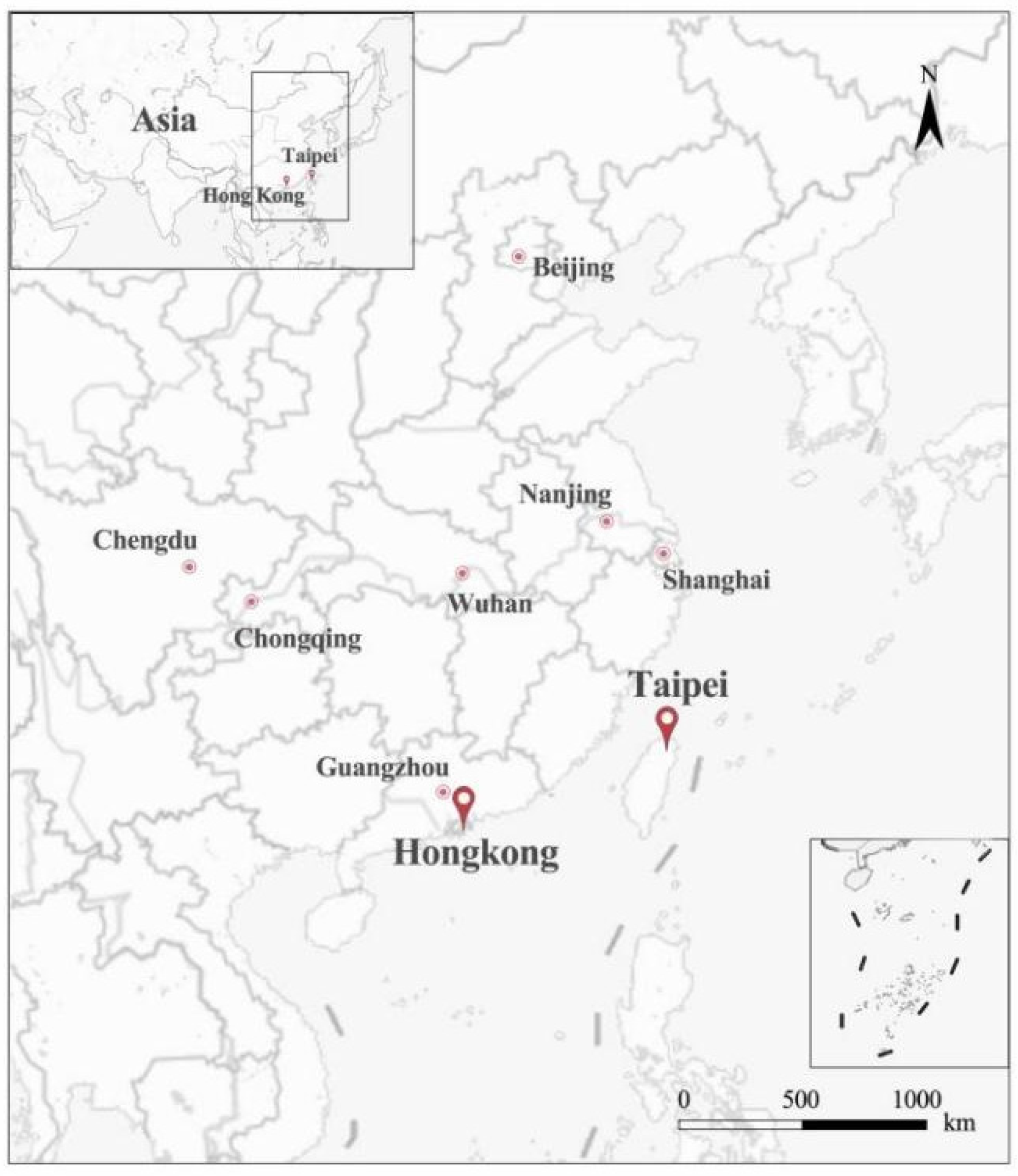
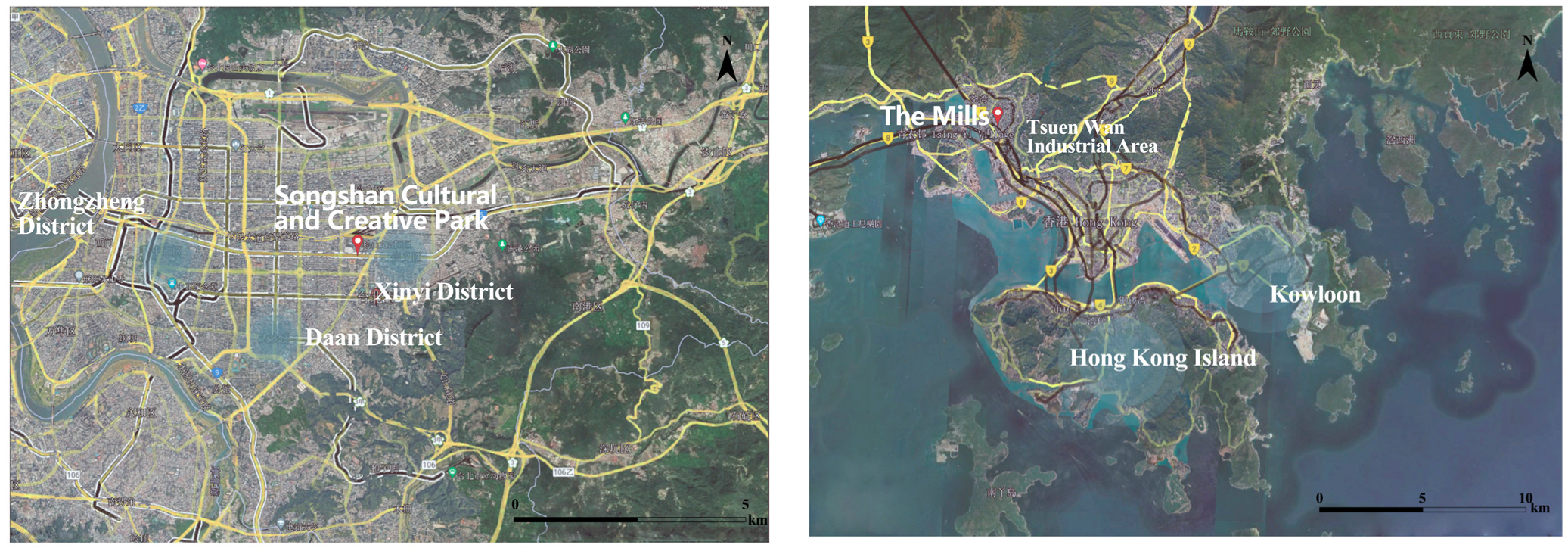


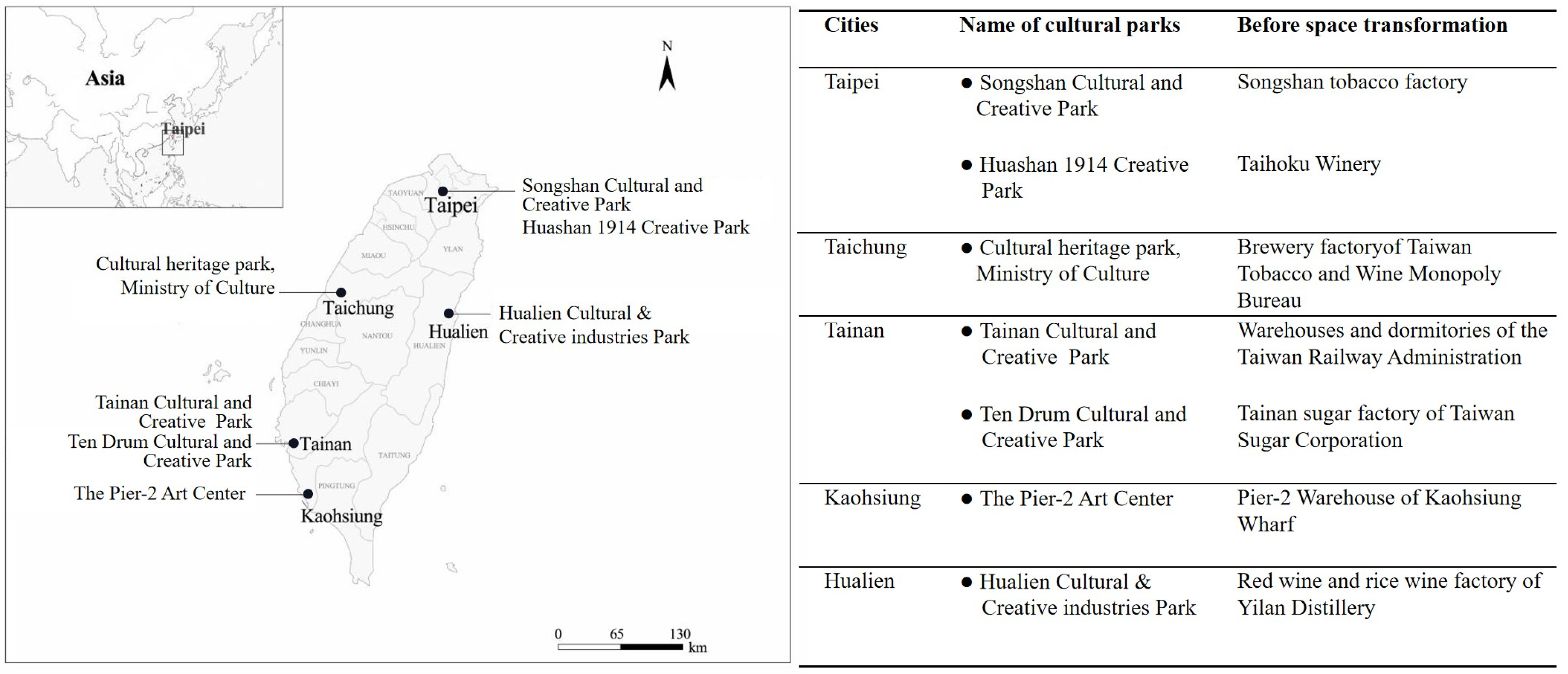
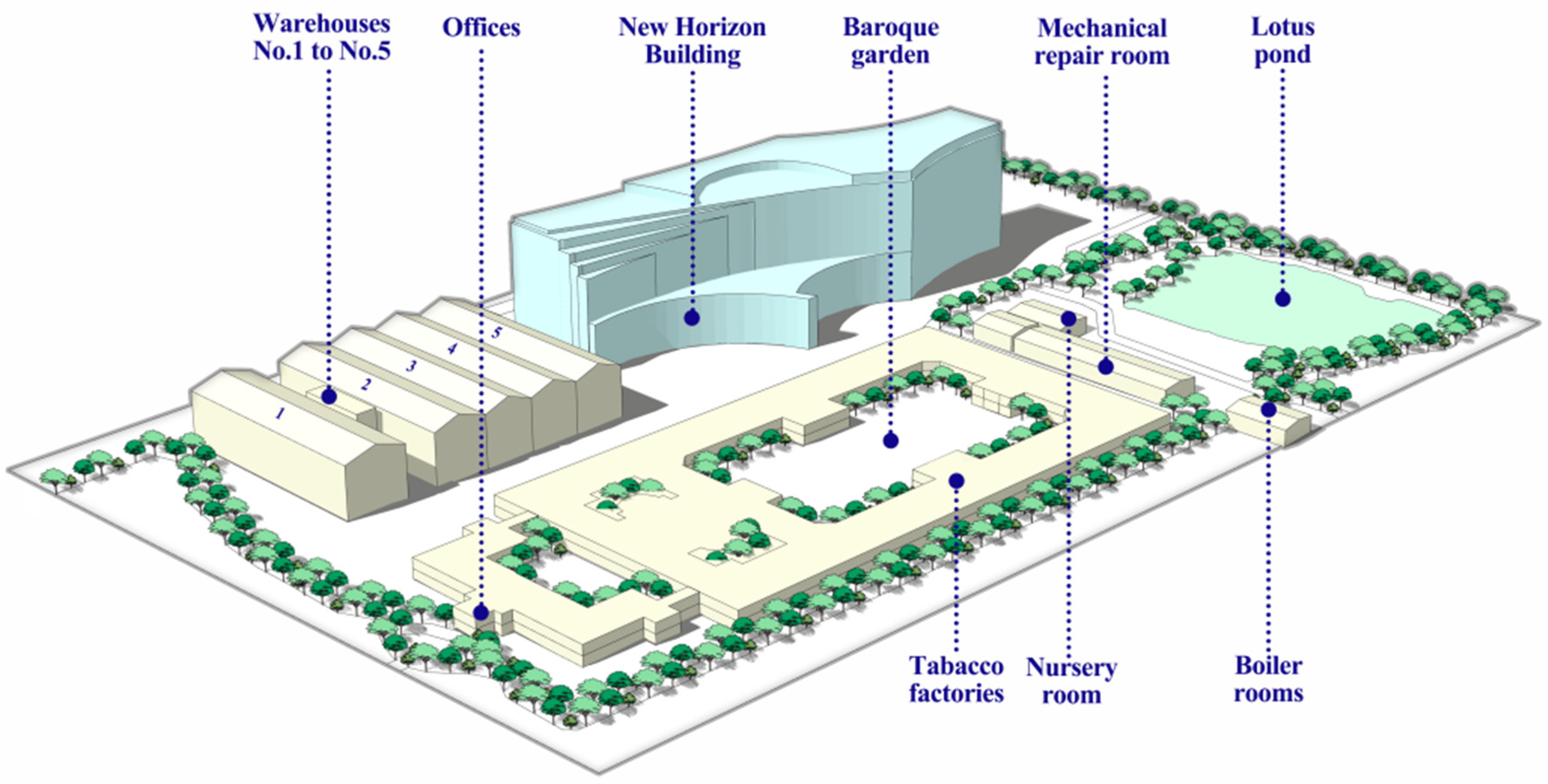
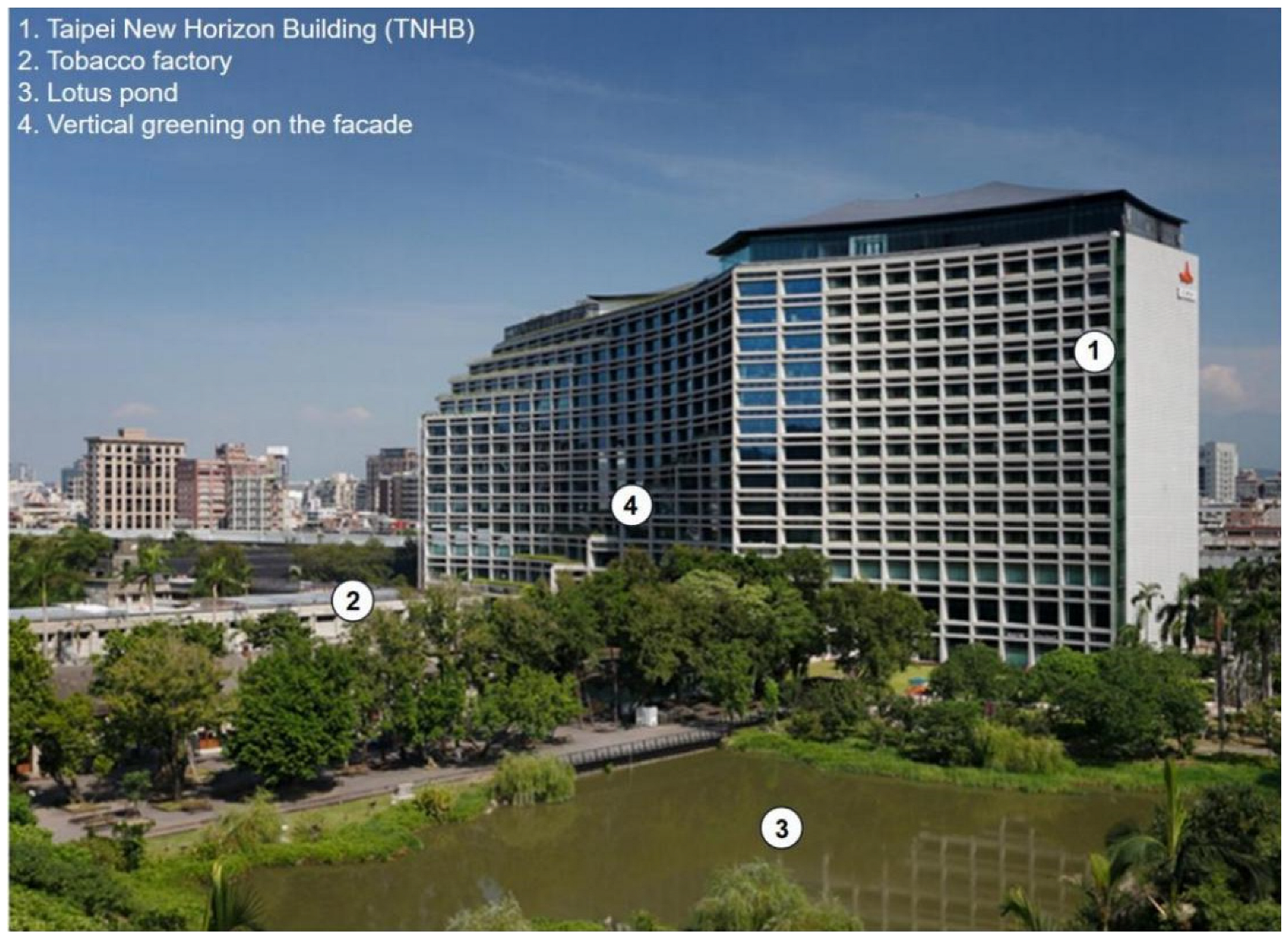
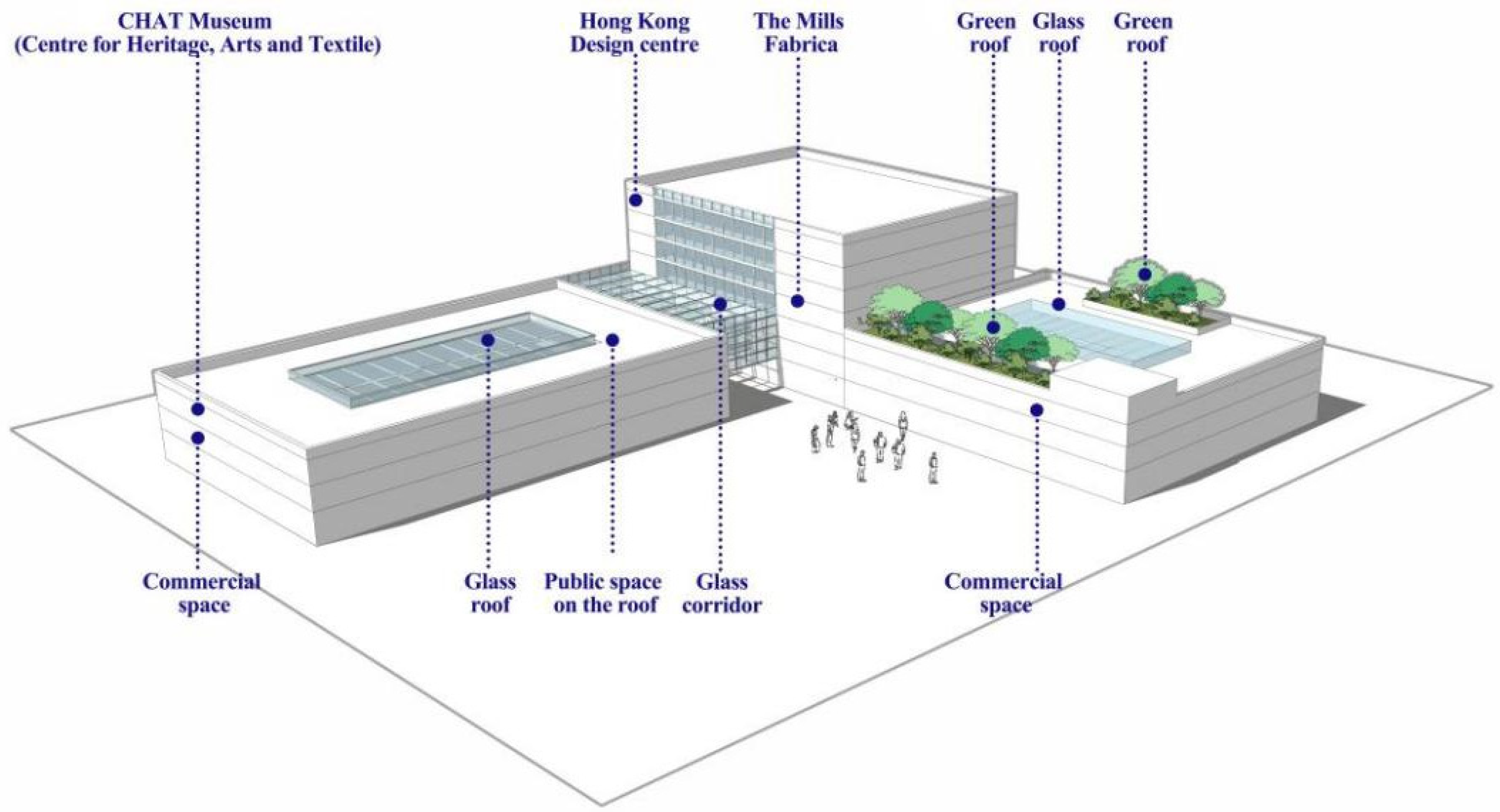
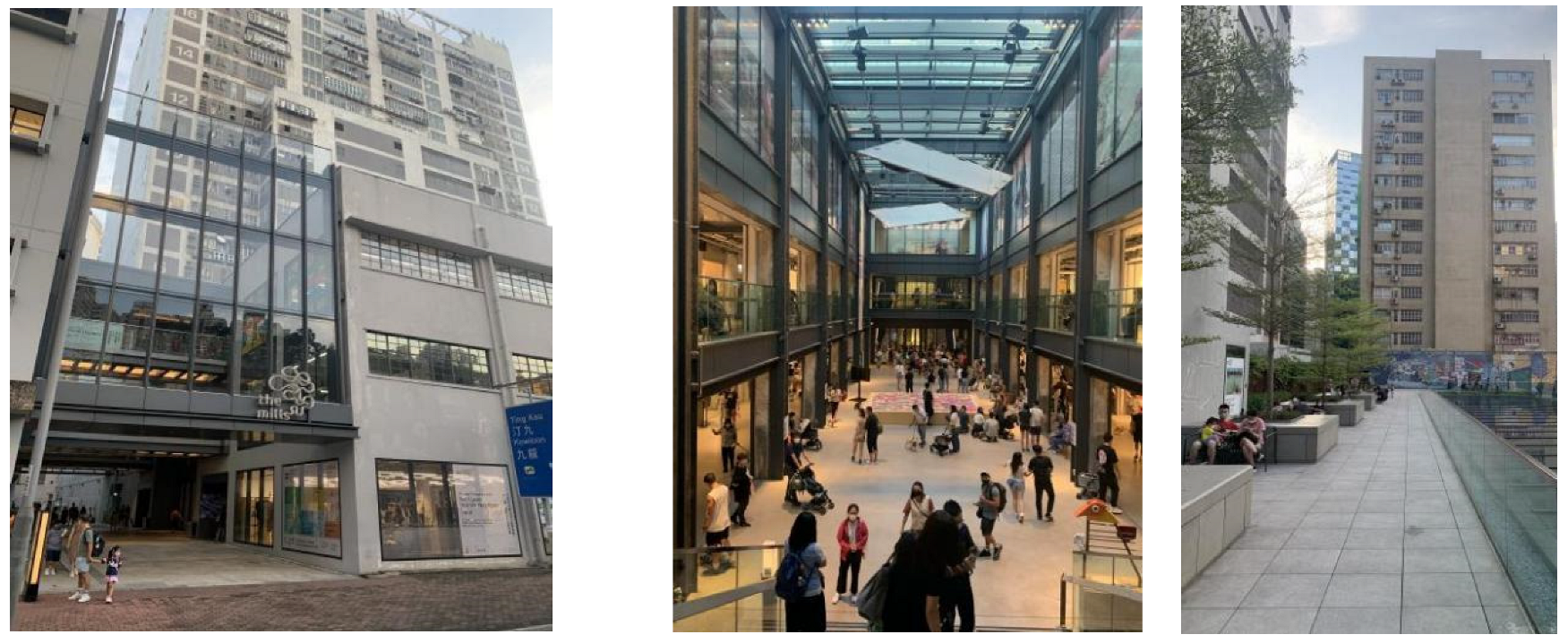

| Cultural Landscape Category | Original Function | Function after Activation |
|---|---|---|
| Municipal monuments | Tobacco factories | Taiwan design museum, creative lab, and creative theater |
| No. 1 to No. 5 warehouses | Multifunctional exhibition space | |
| Boiler rooms | The original appearance has been preserved, and the function has not been updated | |
| Offices | The original appearance has been preserved, and the function has not been updated | |
| Historical buildings | Check room | Small performance space |
| Mechanical repair room | Cultural and creative business | |
| Nursery room | The original appearance has been preserved, and the function has not been updated | |
| Characteristic environments | Baroque garden | Landscape restoration |
| Lotus pond | Landscape restoration | |
| Multifunctional exhibition hall | Multifunctional exhibition space |
Disclaimer/Publisher’s Note: The statements, opinions and data contained in all publications are solely those of the individual author(s) and contributor(s) and not of MDPI and/or the editor(s). MDPI and/or the editor(s) disclaim responsibility for any injury to people or property resulting from any ideas, methods, instructions or products referred to in the content. |
© 2023 by the author. Licensee MDPI, Basel, Switzerland. This article is an open access article distributed under the terms and conditions of the Creative Commons Attribution (CC BY) license (https://creativecommons.org/licenses/by/4.0/).
Share and Cite
Yang, Q. The Social Production of Industrial Heritage Spaces in the Background of Cultural Governance: A Comparative Study Based on Cases from Taipei and Hong Kong. Buildings 2023, 13, 1579. https://doi.org/10.3390/buildings13071579
Yang Q. The Social Production of Industrial Heritage Spaces in the Background of Cultural Governance: A Comparative Study Based on Cases from Taipei and Hong Kong. Buildings. 2023; 13(7):1579. https://doi.org/10.3390/buildings13071579
Chicago/Turabian StyleYang, Qi. 2023. "The Social Production of Industrial Heritage Spaces in the Background of Cultural Governance: A Comparative Study Based on Cases from Taipei and Hong Kong" Buildings 13, no. 7: 1579. https://doi.org/10.3390/buildings13071579
APA StyleYang, Q. (2023). The Social Production of Industrial Heritage Spaces in the Background of Cultural Governance: A Comparative Study Based on Cases from Taipei and Hong Kong. Buildings, 13(7), 1579. https://doi.org/10.3390/buildings13071579





